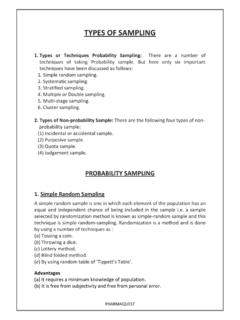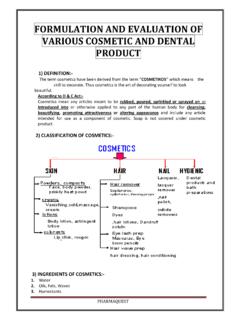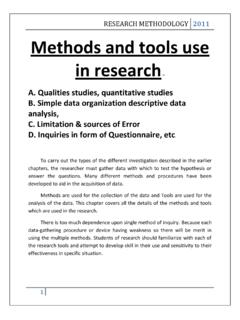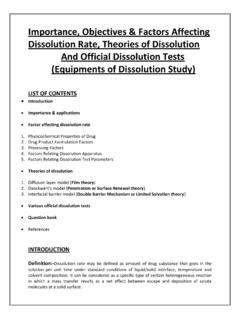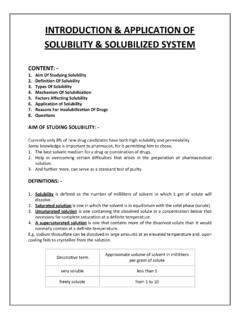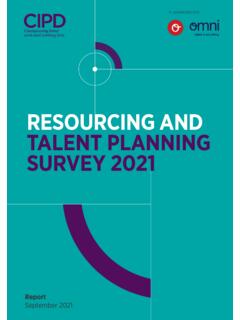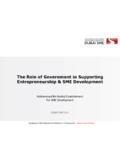Transcription of PRODUCTION PLANNING AND PRODUCTION CONTROL
1 PRODUCTION PLANNING AND PRODUCTION CONTROL POOL OF CONTENT 1) PRODUCTION 2) PRODUCTION management 3) PRODUCTION PLANNING organization chart of a PPMC Department Objectives, Importance, Levels of PRODUCTION PLANNING Steps of PRODUCTION PLANNING 4) PRODUCTION CONTROL [1] PRODUCTION It is the foundation on which every organization is built. PRODUCTION is an intentional act of producing something in an organized manner. It is a fabrication of a physical object through the use of man, material and equipment. The main objectives of PRODUCTION are: 1. Optimum use of resources at optimum cost 2. Manufacture of desired quality and quantity of goods and services in the most efficient and economical way Therefore efficient management of the PRODUCTION function is of utmost importance in order to achieve this objective. [2] PRODUCTION management It is the process of effective PLANNING and regulating the operations of that section of an enterprise which is responsible for the actual transformation of materials into finished product.
2 PRODUCTION management deals with decision making related to PRODUCTION process so that the resulting goods and services are produced in accordance with the quantitative specifications and demand schedule with minimum cost. Form the above definitions it is clear that PRODUCTION PLANNING and its CONTROL are the main characteristics of PRODUCTION management. Functions of PRODUCTION management: 1. Design and development of PRODUCTION process 2. PRODUCTION PLANNING and CONTROL 3. Implementation of the plan and related activities to produce the desired output 4. Administration and coordination of the activities of various components and departments responsible for producing the necessary goods and services [3] PRODUCTION PLANNING It is the function of management which decides about the resources the firm will require for its future manufacturing operations and allocating these resources to produce the desired output in required amount at lowest cost.
3 PP is necessary for directing and controlling the methods used for PRODUCTION and deals with the setting up of PRODUCTION facilities viz. building, machine, equipment etc. in available space. It involves the predetermination of manufacturing requirements such as materials, money; order priority, PRODUCTION process etc. for efficient PRODUCTION of desired goods and services. A representative organization chart of a PPMC Department Objectives 1. Define PRODUCTION management, PRODUCTION function and its component 2. Explain the design of PRODUCTION system and manufacturing process 3. List out the factors influencing the choice of PRODUCTION process 4. To establish targets and checking these against performance 5. To establish routes and schedules for work that will ensure the optimum utilization of materials, workers, and machines 6.
4 To coordinate labour, machine and equipment in the most effective and economic manner 7. To ensure smooth flow of material by eliminating all types of bottlenecks. 8. To utilize the underemployed resources 9. To provide the means for ensuring the operation of the plant in accordance with these plans PLANT MANAGER FACTORY PRODUCTION PRODUCTION PLANNING AND MATERIAL CONTROL PLANT MAINTENANCE MATERIAL CONTROL TOOL CONTROL ESTIMATING AND ROUTING SCHEDULING AND CONTROL ORDER WRITE-UP DISPATCHING AND FOLLOW UP 10. To manufacture the desired output of right quality and quantity at right time. Importance It reduces the cost of PRODUCTION by minimizing the wastage of material and economic utilization of resources. It leads to lower investment by efficient and balanced utilization of sources. It promotes employee morale by avoiding all sorts of bottlenecks.
5 It enhances customer satisfaction and confidence. Scope To liaison with purchase department for efficient and effective procurement of inputs. To liaison with marketing dept, to determine the nature and magnitude of output. To plan the layout of operations indicating in detail the places/points in the system where various PRODUCTION activities/operations are to be performed. Establishment of time schedule for various stages/levels of PRODUCTION by setting up necessary standards. To ensure continuous inspection over the quality of goods manufactured. Instituting necessary controls to complete the work according to schedule. Functions Forecasting to predict customer demand on various products over a given horizon. Aggregate PLANNING to determine overall resource needed.
6 Materials Requirement PLANNING to determine all required components and timing. Inventory Management to decide PRODUCTION or purchase quantities and timing. Scheduling to determine shop-floor schedule of various components. Levels of PRODUCTION PLANNING It can be done at three levels which are: 1) FACTORY PLANNING Here the sequence of work tasks is planned in terms of building, machines and equipment required for manufacturing the desired good sand services. The relationship of workplaces in terms of departments is also planned at this stage. This stage also deals with plant location and layout. 2) PROCESS PLANNING There are many operations involved in factory PLANNING for transforming the inputs into some desired end product. In process PLANNING , these operations are located and the sequence of these operations in PRODUCTION process is determined.
7 Plans are also made for the layout of work centers in each process. 3) OPERATION PLANNING It is concerned with PLANNING the details of the methods required to perform each operation viz. selection of work centers, designing of tools required for various operations. Then the sequences of work elements involved in each operation are planned. Specification about each transfer, work centers, nature of tools required and time necessary for completion of each operation are prescribed. Steps of PRODUCTION PLANNING A. Routing Routing means determination of path or route over which each piece is to travel in being transformed from raw material into finished products. -Kimball and Kimball Under this, the operations, their path and sequence are established. To perform these operations the proper class of machines and personnel required are also worked out.
8 The main aim of routing is to determine the best and cheapest sequence of operations and to ensure that this sequence is strictly followed. IT INVOLVES FOLLOWING ACTIVITIES 1) An analysis of the article to determine what to make and what to buy 2) To determine the quality and type of material 3) Determining the manufacturing operations and their sequences 4) A determination of lot sizes 5) Determination of scrap factors 6) An analysis of cost of article 7) Organization of product CONTROL forms B. Scheduling The determination of time that is required to perform each operation and also the time required to perform entire series as routed is Scheduling. -Kimball and Kimball. It means working out of time that should be required to perform each operation and also the time necessary to perform the entire series as routed, making allowances for all factors concerned.
9 It mainly concerns with amount of work to be done and the time when each element of work will start. Features of Scheduling Description of When and Where of each operation in a PRODUCTION process is to be executed. Establishment of timetable at which to begin and complete each event or operation comprising any procedure. Objectives of scheduling The main objective of scheduling is to arrange the work of the PRODUCTION in such a way that: Items are delivered on due date Prevent unbalanced allocation of time among various department The PRODUCTION cost is minimum Types of scheduling Operation schedule It determines the total time require d to do a piece of work with a given machine or process. It indicates the time required to perform as well as other details of types of materials, machines, labour etc.
10 Required for each and every operation. It takes into account following factors. 1) Physical plant facilities of the type required to process the material being scheduled. 2) Personnel who possess the desired skills and experience to operate the equipment and perform the type of work involved. 3) Necessary materials and purchased parts. Master schedule It is a list showing how many of each item to make in each period of time in future . The nature of master schedule depends on whether the manufacture is to order to stock. The development of master schedule for manufacture to stock begins with a sales forecast. Sequential scheduling It is difficult to define a sequence for multi product plant which passes through a number of departments. If sequence is varied in each department the number of sequences increases will increase and there is no known technique to identify the optimum sequence.

